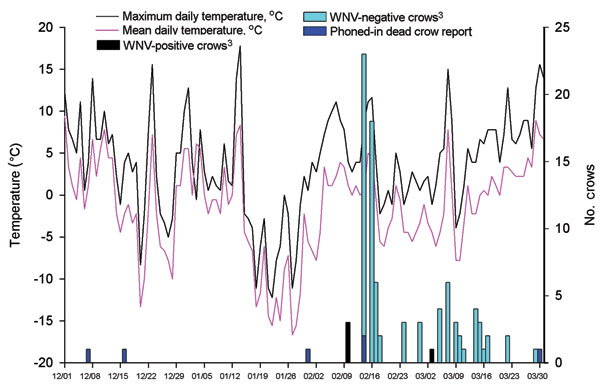Volume 13, Number 12—December 2007
Dispatch
Crow Deaths Caused by West Nile Virus during Winter
Figure

Figure. Crow deaths associated with West Nile virus (WNV) infection and maximum and mean temperatures for Poughkeepsie, New York, USA (December 1, 2004–March 31, 2005). Roost area was checked for crow carcasses at least every 48 hours after February 10, 2005. Temperature data were obtained from National Oceanic and Atmospheric Administration, Silver Spring, Maryland, USA. All 98 crow carcasses were tested for WNV by reverse transcription–PCR (RT-PCR) (2), VecTest, and Rapid Analyte Measurement Platform (3,4). Twelve were positive by all 3 tests; 1 crow collected on March 7, 2005, was positive by RT-PCR only.
References
- Nasci RS, Savage HM, White DJ, Miller JR, Cropp BC, Godsey MS, West Nile virus in overwintering Culex mosquitoes, New York City, 2000. Emerg Infect Dis. 2001;7:742–4. DOIPubMedGoogle Scholar
- Shi PY, Kauffman EB, Ren P, Felton A, Tai JH, Dupuis AP II, High-throughput detection of West Nile virus RNA. J Clin Microbiol. 2001;39:1264–71. DOIPubMedGoogle Scholar
- Stone WB, Okoniewski JC, Therrien JT, Kramer LD, Kauffman EB, Eidson M. VecTest as diagnostic tool for West Nile virus in dead birds. Emerg Infect Dis. 2004;10:2175–81.PubMedGoogle Scholar
- Stone WB, Therrien JE, Benson R, Kramer L, Kauffman EB, Eidson M, Assays to detect West Nile virus in dead birds. Emerg Infect Dis. 2005;11:1770–3.PubMedGoogle Scholar
- Kauffman EB, Jones SA, Dupuis AP II, Ngo KA, Bernard KA, Kramer LD. Virus detection protocols for West Nile virus in vertebrate and mosquito specimens. J Clin Microbiol. 2003;41:3661–7. DOIPubMedGoogle Scholar
- Ebel GD, Dupuis AP II, Nicholas D, Young D, Maffei J, Kramer LD. Detection of enzyme-linked immunosorbent assay of antibodies to West Nile virus in birds. Emerg Infect Dis. 2002;8:979–82.PubMedGoogle Scholar
- Ebel GD, Carricaburu J, Young D, Bernard KA, Kramer LD. Genetic and phenotypic variation of West Nile virus in New York, 2000–2003. Am J Trop Med Hyg. 2004;71:493–500.PubMedGoogle Scholar
- Steele KE, Linn MJ, Schoepp RJ, Komar N, Geisbert TW, Manduca RM, Pathology of fatal West Nile virus infection in native and exotic birds during the 1999 outbreak in New York City, New York. Vet Pathol. 2000;37:208–24. DOIPubMedGoogle Scholar
- Ward MR, Stallknecht DE, Willis J, Conroy MJ, Davidson WR. Wild bird mortality and West Nile virus surveillance: biases associated with detection, reporting, and carcass persistence. J Wildl Dis. 2006;42:92–106.PubMedGoogle Scholar
- Eldrige BF. Diapause and related phenomena in Culex mosquitoes: their relations to arbovirus disease ecology. Vol. 4. In: Harris KF, editor. Current topics in vector research. New York: Springer-Verlag; 1987. p. 1–28.
- Komar N, Langevin S, Hinten S, Nemeth N, Edward E, Hettler D, Experimental infection of North American birds with the New York 1999 strain of West Nile virus. Emerg Infect Dis. 2003;9:311–22.PubMedGoogle Scholar
- Reisen WK, Fang Y, Lothrop HD, Martinez VM, Wilson J, O’Connor P, Overwintering of West Nile virus in southern California. J Med Entomol. 2006;43:344–55. DOIPubMedGoogle Scholar
- Kipp AM, Lehman JA, Bowen RA, Fox PA, Stephens MR, Klenk K, West Nile virus quantification in feces of experimentally infected American and fish crows. Am J Trop Med Hyg. 2006;75:688–90.PubMedGoogle Scholar
- Ward MP, Raim A, Yaremych-Hamer S, Lampman R, Novak RJ. Does the roosting behavior of birds affect transmission dynamics of West Nile virus? Am J Trop Med Hyg. 2006;75:350–5.PubMedGoogle Scholar
Page created: July 06, 2010
Page updated: July 06, 2010
Page reviewed: July 06, 2010
The conclusions, findings, and opinions expressed by authors contributing to this journal do not necessarily reflect the official position of the U.S. Department of Health and Human Services, the Public Health Service, the Centers for Disease Control and Prevention, or the authors' affiliated institutions. Use of trade names is for identification only and does not imply endorsement by any of the groups named above.